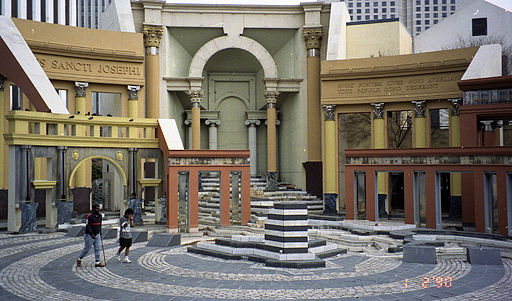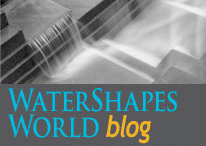New Orleans
The watershape was way off any path I'd ever beaten around New Orleans: It sits north of downtown along the shores of Lake Pontchartrain, and I was genuinely surprised to make its acquaintance.
This was back in November 2016, when my wife and I were heading with my brother and his wife to their home in Mississippi after my work at International Pool|Spa|Patio Expo drew to a close. We rolled up West End Boulevard to where it turned into Lakeshore Drive, figuring we'd move along the waterfront until we could conveniently jump over to Interstate 10 and leave the Crescent City behind.
But soon after we made the right-hand turn along the water, I spotted a fountain and made us stop: We'd essentially tripped over the Mardi Gras Fountain, which I'd never heard of before, and paused briefly to give it a look.
It reminded me immediately of the fountain in the Plaza de España (click here), which I'd seen many times through the years while walking along the Mississippi River toward the convention center. Both installations feature lots of tile plaques, but I found those associated with the Mardi Gras Fountain to be much more interesting because they colorfully memorialize the various carnival krewes that participate in local parades and various other Mardi Gras festivities.
I was a big fan of the HBO series Treme and saw a unique part of New Orleans heritage coming to life before my eyes.
The fountain itself, however, wasn't all I might have hoped. Yes, the water danced with gusto, with clusters of jets sending water to various heights in a varied array of patterns. But if ever a themed fountain called for music, this one is it: While the jets conjured some of the visual magic of a New Orleans parade, without sound (other than the watery kind) it all fell a bit flat for me.
Since returning to California, I've read up on the Mardi Gras Fountain and have come to appreciate its unusual history. First dedicated in 1962, it was designed by Blaine Kern in association with a local architecture firm. Kern was no fountain guy: He was a Mardi Gras float designer who came back from a trip to Europe filled with impressions of great fountains and started a personal crusade to get one built in New Orleans.
The original fountain came in with a modest outlay of $42,000, including 70 tiled plaques set like teeth around the basin. The fountain shot water 30 feet into the air, and on warm summer evenings, all lit up, it drew substantial crowds to water shows. But by the 1990s, the watershape had fallen on hard times and was decommissioned.
In May 2005, the fountain was treated to a $2.5 million restoration, with new electrical and mechanical systems to go along with new paving and landscaping. Hurricane Katrina massively abused both the fountain and its park just a few months later, and it was 2013 before another hefty infusion of cash brought the space back to life with a new set of upgrades and a bunch of new tile plaques.
Knowing what I now know about the fountain and its story, I'm more inclined to be charitable about its musical shortcomings and accept it on its own considerable merits. It has its shortcomings, in other words, but I appreciate it for what it is - a wonderful, personal celebration of New Orleans' Mardi Gras heritage and generations of urban (and urbane) entertainment.
Bottom line: The fountain's fine. As for the plaques, they're cool beyond belief.
For a video of the fountain after dark, click here.
During the recent International Pool|Spa|Patio Expo, I stayed in New Orleans at an unfamiliar hotel three or four blocks off the waterfront and a couple blocks from the French Quarter. I arrived late and didn't have the opportunity to get my bearings, so I started the next day by opening the drapes to survey the city from my 13th-floor vantage point.
It was a first for me: In all of my travels, I've rarely ever stayed in a hotel with a 13th floor, let alone been assigned a room on one. And as unluckiness would have it, the view to the horizon wasn't much, just the tops of warehouses with a big bridge in the middle ground.
But straight down below me was a strange sort of park with odd walls, a clock tower, a colonnade and a structure that suggested the Grand Canyon to me. I checked it out before heading over to the convention center and saw that it was called Piazza d'Italia. In walking through the space, I soon recognized that the canyon-seeming formation was a fountain basin and that the "excavation" was shaped like the Italian peninsula, with Sicily lashed on at the toe of the boot to complete the package.
The view from my hotel window. (Please pardon the glare!)
I took some snapshots and, when I returned to my room that evening, learned that the space had been designed by the internationally renowned post-modern architect Charles Moore in association with Perez Architects, a local New Orleans firm - and that it had started a steady slide to dereliction almost as soon as it was completed in 1978.
I also learned that the piazza had been fully restored in 2004 - but I can't swear by it's current status, because it wasn't operational for the week I was there. It's often called the first post-modern ruin, which is amusing. But it was just plain sad to see how much effort had gone into creating a space that just didn't seem to belong.
It's a nasty twist of urban planning and New Orleans history: The piazza was intended to spur a neighborhood revival, but the city never caught up with the program despite the fact that several nice restaurants, including one of Emeril's local outposts, had come to the area.
So instead of being the core of a vibrant village, Piazza d'Italia is caught in the shadow of a huge hotel and cut off from nearby streets by a big parking lot that replaced a bunch of old buildings that at some point had the misfortune of catching fire. In fact, if I hadn't found the space from above, I seriously doubt I would ever have spotted it from street level.
It's almost beside the point that I don't really like the piazza, with the fountain operating or not. There's little to love in the self-indulgence and self-satisfaction that marks so much of post-modernism, from the winking references to antiquity and classical forms to the rib-nudging use of neon in the lighting program. I know I haven't seen Piazza d'Italia at its best, but in both concept and execution it seems overblown in the way so much architecture was at the close of the last century - too divorced from the immediacy of human experience to be beloved, a stage without actors, an uncomfortable public forum.
Maybe splashing water would help, but don't quote me on that because being inoperative when I saw it was only one problem among many. It's still worth seeing, I'd say, but it's just so weird!
To learn more about the fountain and piazza (and see many more photographs), click here.
Designers and builders tend to think about water as a beneficial feature, an artistic medium, a resource for exercise and hydrotherapy and beauty and awe. You all experience that water at its contained, controlled best and know exactly how much joy and delight flow when people are in or around water as part of their daily lives. But this material, as has often been stated in
I've just returned from the 2016 International Pool|Spa|Patio Expo - a bit tired but, as usual, satisfied with the experience. As I had hoped, I enjoyed lots of conversations about future articles and an unusual number of chats about advertising and sponsorships. Also, the show took place in New Orleans, so I had a
This edition of the WaterShapes newsletter is appearing on the opening day of the International Pool|Spa|Patio Expo. By that Wednesday, I will have been in New Orleans for two days - and will have landed late enough on Monday evening that I will have missed all of the Hallowe'en festivities. That's fine by me: I've been in New Orleans for three















